How To Open A Bar (10 steps)
Want to know how to open a bar? From licenses to staffing, learn the 10 essential steps to turn your dream bar into a thriving business.
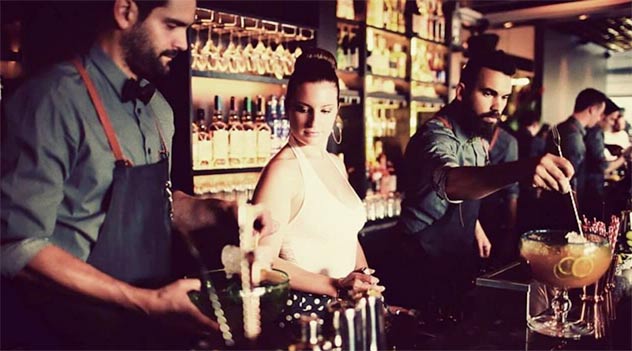
Want to know how to open a bar? From licenses to staffing, learn the 10 essential steps to turn your dream bar into a thriving business.

How to open a bar (for dummies) should be the title of this post. Written by our key contributor, get an in depth walkthrough on the steps to opening a lounge, club, or bar, find out the costs of starting a bar, and read about the tips on opening a bar business. We’ll touch upon bar management for dummies as well as these steps to starting a bar for yourself.
___
I’m pretty sure everyone at one point in their lives has dreamed of opening a bar, pub or tavern. For most people (at least in the U.S.), they want to start a bar business around age 21 when they start legally drinking. For me, I wanted to open a bar when I was much younger. I quite literally grew up in a bar. My dad ran one, and even my grandpop owned his own brewery back in the old country.
Honestly, there’s nothing else I ever pictured myself doing… So you can imagine my joy when I opened my very first bar!
…And the depression I went through when I had to shut it down three years later…
A lot of people are under the impression that a owning a bar is fun: The booze. The glamour. The girls.
You pretty much spend your days feeling like the king of the world, and that’s true. But the part everyone leaves out is the details: Late nights doing inventory, drinking your profits away, theft, security, payroll, rent, utilities, customer service… [Shudder] Cleaning. And not just cleaning, but deep cleaning. If you’ve ever worked at a bar, you know what I’m talking about…
I learned by failing. And what I picked up from failing at O’Sheas taught me the lessons I needed to learn in order to get where I am today; running a thriving bar and feeding my beautiful family.
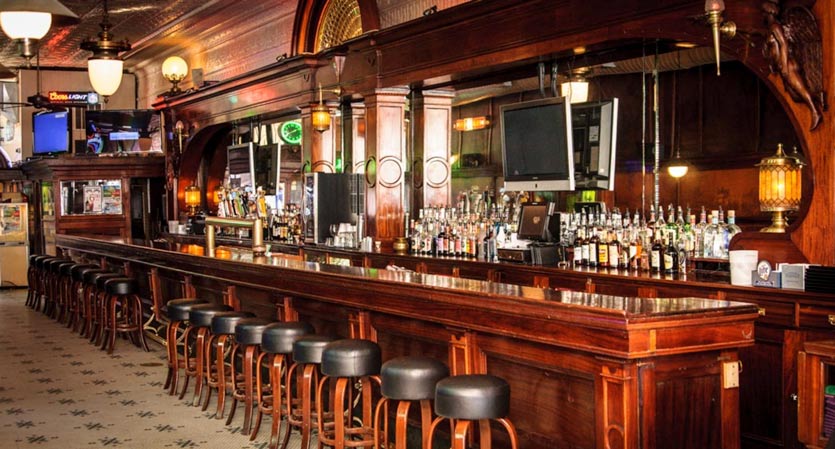
Fortunately for you, I put those lessons into writing. And by the time you finish reading my post for StartupJungle.com, you’ll know everything you need to do (and not do) to open your own bar.
Can I guarantee your success? No.
But I can help you avoid the mistakes I made and teach you the things I wish someone would’ve told me before I got started. I can also guide you through the process of getting your bar off the ground, and what to expect when you open the doors and grow.
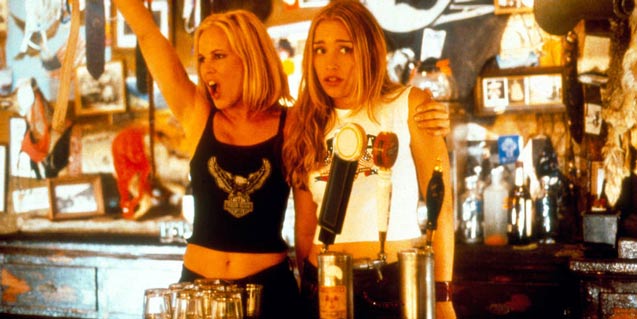
This seems like a pretty obvious starting point, right? You would be amazed at how many people skip this step.
I know I did.
We’ve all got assumptions about what it’s like running a bar, and we all know we’re right. Right?
So we find “the perfect place” and think of “the perfect theme” and know that if we just want it bad enough and work hard enough, good things are bound to happen.
But that’s not the way it works.
Do some research!!!!! For example:
Some of these questions you can easily find with just a little Google searching. Most of these you cannot. You’ve got to go out and ask, possibly even work at another bar to understand all the inner workings of learning the bar business beyond what Google will tell you.
I just kind of winged it with O’Shea’s. And boy did I pay for that. Literally.
Doing your research ahead of time and understanding how a bar business actually works will save you a LOT of trouble in the long run.
Now that you’ve done your research and understand what you need to do in order to actually open a bar, let’s take a look at what needs doing to take that idea from a concept to a reality.
The way I always heard it was “a goal without a plan is just a dream”. How true that turned out to be. Except, in my case, it was a bad dream…
So having a plan is a must. Not just a rough idea, but a well thought out detailed plan.
For starters: What kind of bar do you want to have?
Sports bar?
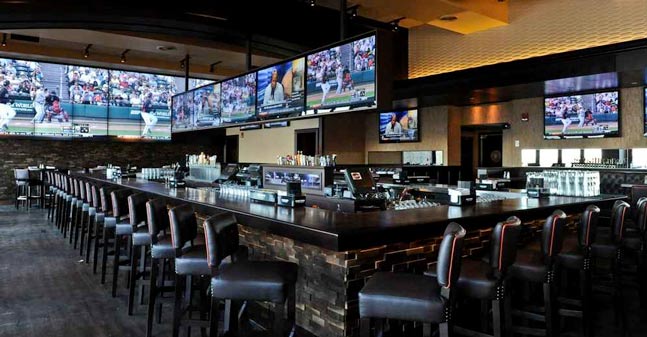
Dive bar?
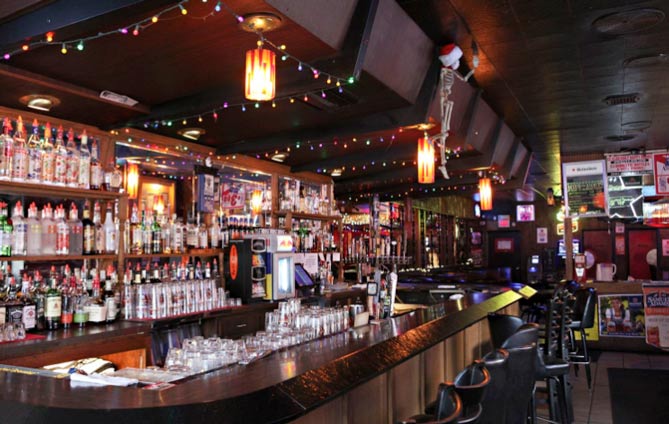
Specialty bar?
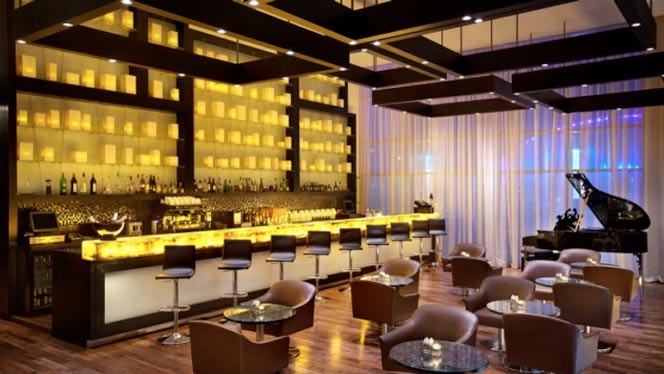
Start with the idea, then map it out.
TIP: Think of your plan as a timeline.
Timing everything properly can not only make your business run more smoothly but can save you money.
What’s your opening date? Now work backwards. How soon can you get a contractor in to look at the place? How much does s/he cost? Inspections? Permits? Mark the dates of all these down on a big giant timeline.
I highly recommend using an entire wall and covering it in paper or whiteboard paint and drawing out a massive timeline to input points on there.
Every business is different. Even in the same industry, different stores will have different owners who express themselves in different ways.
But regardless of the industry you’re in, there are certain things a business owner can do to give yourself as much of a chance to succeed as possible. And whether you’re opening a bar, a restaurant, a clothing store, or a salon, understanding those things is a must.
To make it easy to digest, let’s look at this as a timeline. What’s your opening date? Now let’s work backwards.
Here’s my roughly guided timeline if I were to do it all over again:
Now, there’s a LOT not on that timeline. Remember, this is a guide – not a customized blueprint. I want to give you an example of how specific you need to be. Every bar is different, so one timeline may not be applicable towards another. The important thing is to understand how long every single piece takes and when to begin the process.
I have a more detailed YEAR OUT timeline laid out in an infographic. Just click the image below:
Once you’ve got that mapped out, put a lot of thought into hiring, training, and marketing. Speaking of which, hiring is not as simple as it sounds. Wanna do it right? Identify the traits you want to see in your employees and look for that in the interview process. Don’t just wing it, and DO ALWAYS check references!
I kick myself in the arse for skipping the reference check after finding that I’ve got bad apples…
And then comes training.
This guy is mesmerizing.
While you may be looking for “turnkey” bartenders who are already trained, you can’t just assume everyone who comes on as an employee knows the “right” way to do everything. You’ll have to watch them in action and weed out any bad habits, or policies that aren’t aligned with your expectations.
Some people may not know how to make anything but have an amazing ability to connect with customers. Others may be ‘startenders’ but need a little coaching on customer service.
It’s important for a bar to be consistent, which is why training is so important. Every bartender needs to make every drink exactly the same way.
If not, one of two things happen:
Both are bad for business, and the reason behind why it’s crucial for a bartender to put a plan into place when opening.
My biggest piece of advice I can give to you is to document everything in writing and have procedures for everything from opening duties to closing duties to how to make every single drink on the menu.

How much alcohol in it? 1.25 ounces? 2 ounces? How about the mixers?
An actual procedure makes every drink exactly the same, meaning it doesn’t matter which bartender is working, the customers will always know exactly what to expect. It also saves you money from bartenders having a heavy pour on booze and/or mixers.
And, more importantly, having precise measurements of your drinks means you know how much each drink costs, and what to charge for them to make a profit.
I’m sure every single employee you bring when starting a bar will be a homerun, but protect yourself and your business by creating a plan – for them, and for everything.
Creating a business plan is a lot of work, and if you want to know how complete your business plan is, you definitely want to download Startup Jungle’s Business Plan Grading Rubric. These are the things to look out for when writing your plan.
A new bar, at least in your mind, is sure to be a goldmine. ALL your friends will come. And they’ll all bring ALL their friends. What can go wrong? The truth?
A lot.
If you’ve ever seen the TV show Bar Rescue with John Taffer, you know there’s always the scene where he pulls out the city map and highlights the area around the bar. Then he talks about how many people live in that area and their demographics.
How much money does each person in the area make on average? It’s so important to understand your bar’s earning potential so you can set a budget and manage investor (and your own) expectations.
A successful bar can be profitable in just a few months, and you can even make back all your investment in as little as three years. But understanding your bar’s earning potential is key to plotting a course to profitability.
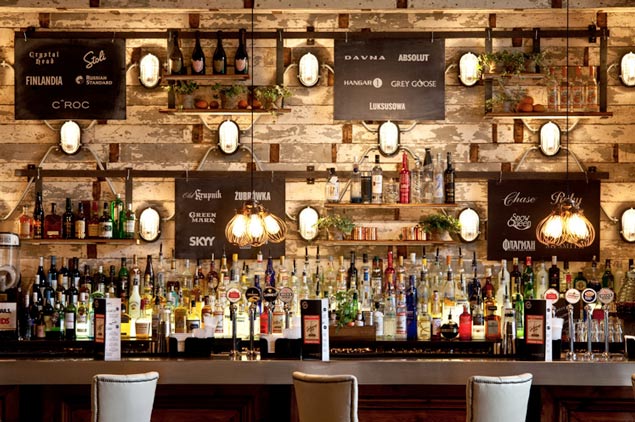
If you run out of money, the bar closes. And no one wants that.
So look at the area in which you’ll be opening your bar and decide if it’s actually a good area. Think about more than just quantifying info. Think about qualifying your market, too.
For example, health and fitness nuts tend to avoid booze, so while areas with lots of healthy, fit, environmentally conscientious people may seem like a smart bet, you may find they drink very little, if at all. Understanding your audience can save you from overextending your business.
Then you need to price out every drink and food item on the menu.
You better always have plenty of it. And maybe hold off on ordering that giant case of Fernet and just get 1-2 bottles. Spending money properly can help stretch every dollar really long way.
Because I care about your success and want to do whatever I can to help make things easier for fellow bar owners, I made this excel cheat sheet for your Drink Cost Calculator. Click Below to download.
Understanding your earnings potential can only help your business, so make it a priority and document this well.
Here’s a secret for you: Revenue – Costs = Profit.
I always forgot about that pesky little “costs” piece. I drank on the job – a lot – and thus drank my profits. That profit is what will keep your bar running. But equally important to profit is understanding your costs and budgeting for them.
If you can’t make payroll because you overspent on marketing or inventory, you may not have any employees to serve your people. And while you may think “hey, no problem I’ll do that!”, you don’t want to do that.
I tried that one weekend…
I was a one-man bar machine!
Except, I was one man serving 100. And I was too slow.
I lost a lot of potential regulars because of how long they had to wait. So budgeting for employee payroll is not something to disregard. So the moral of that little story is to pay your employees and pay them on time.
And speaking of employees, part of your budget is scheduling them properly.
Here’s a great set of principles to follow when scheduling bartenders.
It’ll take some time, but eventually, you’ll pick up the art of scheduling. There’s a fine line between overstaffing and understaffing your bar, and that’s for you to figure out. But you’ll get the hang of it, and that’ll help to keep your costs down.
A budget keeps your bar operational, and the more specific you can make it, the better.
Your biggest cost is always going to be payroll, but what about your other costs?
Write out your budget and STICK TO IT!
Your bar (and your bank account) will thank you.
This one is fun. Brainstorm what kind of bar you’ll be. Go crazy. There are no bad ideas!
But remember, this isn’t about what you want so much as it is about what your customers want.
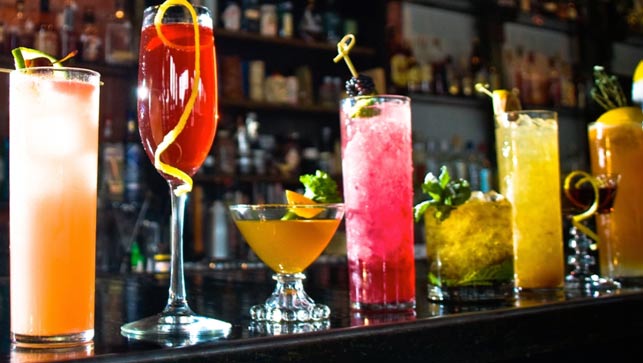
Creating an alternative to Hooters sounds fun, sure. But is that really what your customers want? And is that what you really want? Or is it just a fun little fantasy?
The idea and reality of flirting with or sleeping with an employee are two VERY different things.
So be very clear on what you want – and what you DON’T want. Here are some questions to ask yourself:
Figure out what makes your place special–Why should people want to come there?
One of my favorite analogies is to the engineer’s triangle: Good. Fast. Cheap. You can always have one, sometimes two, but never all three.
Figure out what you want to compete on – quality, service, or cost – and go from there.
Here are some drink recipe references that I’ve found helpful to me:
The basics, a fantastic article + recipes
Check out some beautiful bars and are on my bucket list:
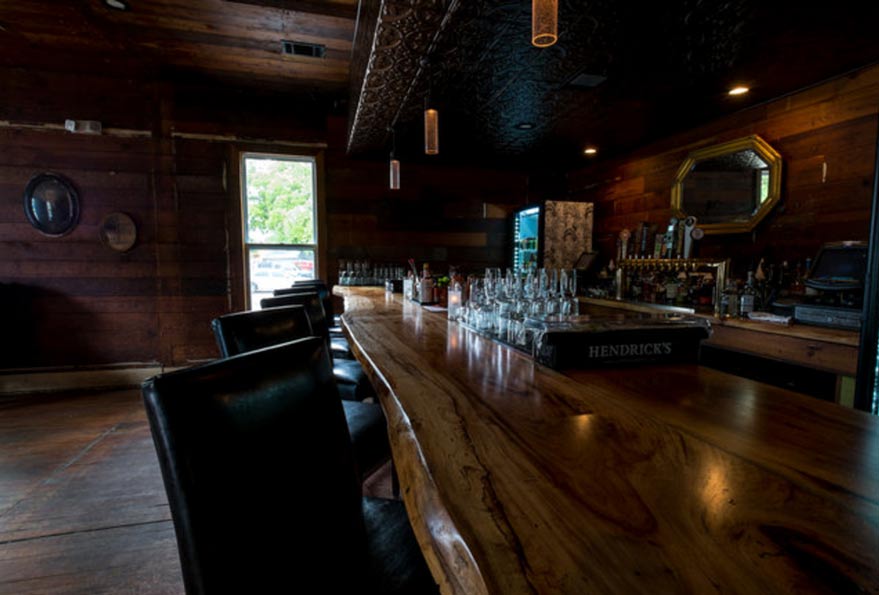
Look at that wooden bar. Everything about this bar screams Texas. It’s got a modern feel along with the rustic quality that makes Texas, uniquely Texas.
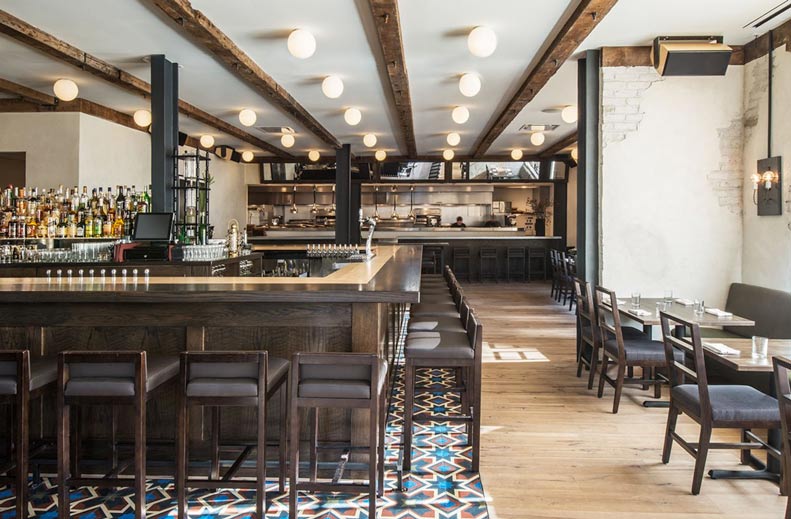
You can probably tell I find wood bars and masculine chairs beautiful. Sure I like the swanky modern places, but I feel at home in a bar that is comfortable and dark. This bar has a lot of light, which is perfect for happy hour or a lunch outing with the guys.
So this one should be done at the beginning, but I put this step here because I wanted you to already understand a lot of the ideas that go into this.
Remember the whole “budget” piece? And “understanding your bar’s earning potential”? Yep. Those things matter in selecting a location.
Just look at Austin, TX’s downtown bar locations. Notice how they’re all clustered together to form bar districts for optimal drink bar hopping…
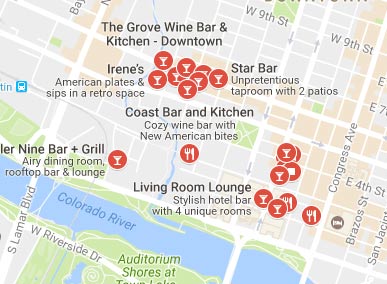
It’s important to try and find a good balance of rent costs and earnings potential, in an area you actually like. You want employees excited to come to work, and being in a hip, cool area is great for that. But even better than being in a hip, cool area is being in a place which generates lots of profit.
So choose wisely, and plan ahead!
Select a location based on smart thinking, not just on an emotional reaction to loving a building or view.
Some things you should consider other than rent when selecting a location are:
Starting a bar is hard work, so make it a little easier by picking a great location.
Here’s a great set of ‘hard knox’ principles when choosing a location for your bar.
So what equipment do you need to open a bar? Well, that depends on which type of bar you want. But some things are universal.
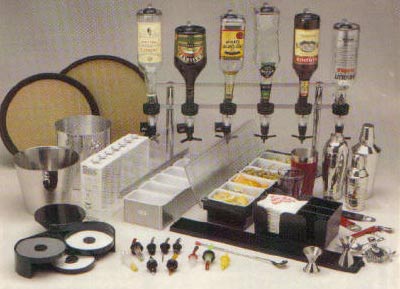
For starters, you’ll need alcohol. Look up liquor and beer distributors.
You’ll need glassware (and lots of it, if you account for breakage).
Plates and Silverware? You’ll need those if you’re serving food.
Games?
Dishwashers?
What about bottle openers and wine keys?
Don’t forget about decor as well.
Go check out a bar you like and look around at what they’ve got in action. Write it down. Then go research where they got it and how much it all costs.
Another great resource to find bar decor inspiration is on the web. Here are some great sites I recommend:
Remember, you’re on a budget!
We’ve round up a list of supplies and essentials you’ll need to make it easier for you. Just click below to download.
This can be a bit tricky.
A business has almost unlimited options when it comes to promotions.
But as a new business, your bar needs to promote itself wisely.
Social media is a GREAT tool! And your staff should want to help, too. After all, the more people in the place, the more tips they make. Some great affordable options are Facebook local awareness ads, which allow you to target specific genders and ages in a selected physical area around your bar.
Word of mouth is a great tool, that is often overlooked in today’s increasingly digital world. As are flyers. Go out and hoof it. Put that paper up wherever you can.
Coffee shops.
Gyms.
Parks.
Put them on car windshields!
And if you’ve got personable bartenders, have them stand outside and bring people in.
If you’ve got the funds, do some radio promotions. Sponsored ads on Google and Yelp are great, too!
If you join your local chamber of commerce, there’s generally a ribbon cutting ceremony which always gets news coverage.
My personal favorite way to promote a bar is to find an influential person to act as a microphone and scream it out. When I was running a college bar, I would go to the social chair of each and every sorority and tell her to bring in all her friends and I’d give them a bottle of champagne. That $3 cost to me brought in a group of girls, who in turn brought in groups of guys, who in turn spent lots of money on shots and drinks.
But you don’t have to deal with frats and sororities.
Find bloggers, or Yelpers, or local celebrities. Reach out to them and invite them to check out your new place and have a (free) drink or 2.
It doesn’t matter how great a place you have if no one knows about it, so figure out ways to promote your bar which fit your budget.
There are some great localized advertising options out there. Here are a few I recommend:
I know I’ve already touched on this, but I wanted to review it once more to emphasize how important it is.
Labor will always be your highest recurring cost, so it’s important for you as a business owner to keep labor as low as you can without harming your business.

If you consistently schedule too many bartenders, they won’t make as much money and may lose interest in your bar, eventually leaving you for greener pastures.
On the other hand, if you under staff, your bartenders may get frazzled and feel overwhelmed by how much there is to get done.
You’ll come to understand the needs of a bar, but here are some pointers.
Remember that it’s their job but it’s your business, so you set the rules and they’ll fall in line. Staff as you need, not as they want, and help your business extend every dollar.
It’s equally important to check in with your staff on a monthly basis to talk about recurring problems and inefficiencies. Take them out to lunch and give them a place to voice those concerns.
The bar community is a fun group.
Most bars always have an “In the Biz” night or “Service Industry” night.
These are great opportunities to network, and your bar should absolutely do the same.
Look for events which you can attend to meet other bar owners and bartenders.
One of my personal favorites is the Jameson Bartenders Ball (nationwide, just search on google), which is a traveling event hosted by Jameson. Lots of booze, lots of new friends, and lots (and lots!) of fun.

Additionally, check out meetup.com for local industry get-togethers in which you may be interested.
Unfortunately, you’re going to get a lot of solicitations from communities and chambers of commerce. Do your due diligence prior to joining, so you know if it’s worth your money and time.
You never know when (or where) you may find the missing piece to your bar’s success, so be active and engaged in the bar scene, not only in your area but all over.
Here’s a great infographic we made about the alcohol industry:
Bottom line: Opening (and running) a bar is a lot of work.
But if you do it right, it’s not only rewarding, it’s a lot of fun. I wake up in the morning (well, afternoon) with a smile on my face. I love being my own boss and I love having a business which brightens people’s lives.
Hopefully, you put this guide to use. If this was helpful for you and you want to learn more about starting a bar, StartupJungle.com has a 21 point checklist for starting your new business. In addition, you’ll want to check out Perry Belcher’s Growth Hacking video about how to grow you bar and keep seeing that cash register ring. Make sure you download this and start planning the opening of your very own bar!